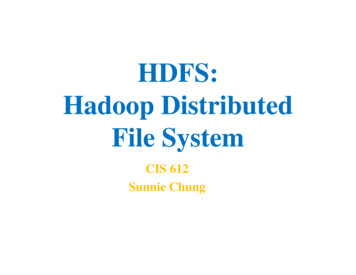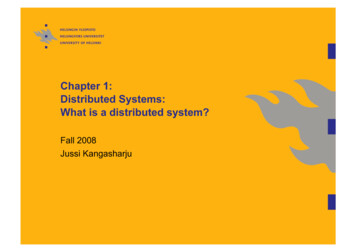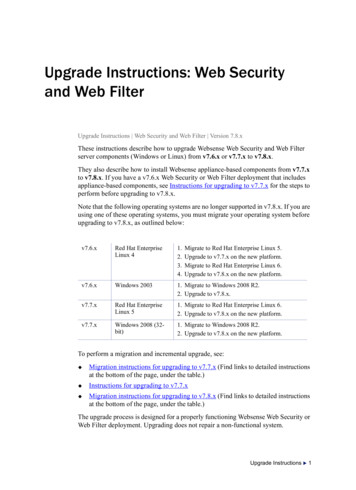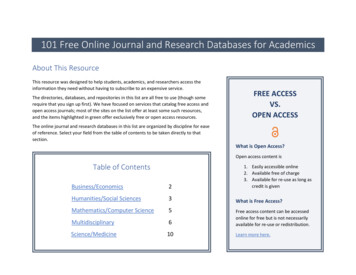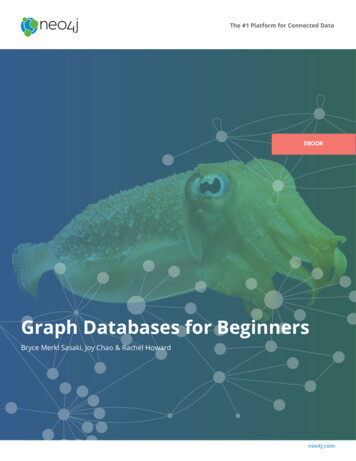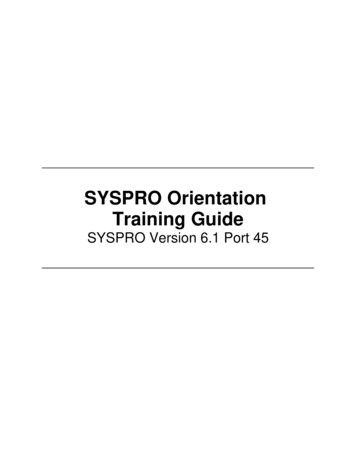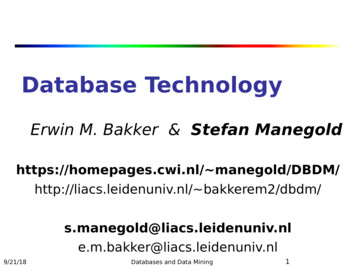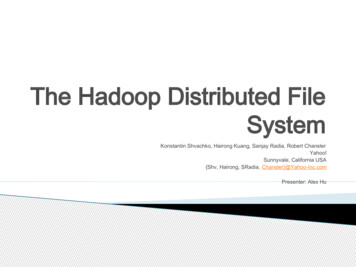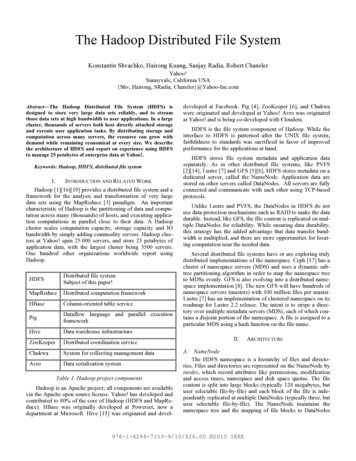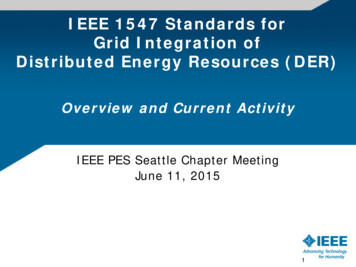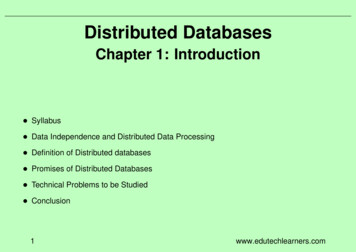
Transcription
Distributed DatabasesChapter 1: Introduction Syllabus Data Independence and Distributed Data Processing Definition of Distributed databases Promises of Distributed Databases Technical Problems to be Studied Conclusion1www.edutechlearners.com
Syllabus Introduction Distributed DBMS Architecture Distributed Database Design Query Processing Transaction Management Distributed Concurrency Control Distributed DBMS Reliability Parallel Database Systems2www.edutechlearners.com
Data Independence In the old days, programs stored data in regular files Each program has to maintain its own data– huge overhead– error-prone3www.edutechlearners.com
Data Independence . . . The development of DBMS helped to fully achieve data independence (transparency) Provide centralized and controlled data maintenance and access Application is immune to physical and logical file organization4www.edutechlearners.com
Data Independence . . . Distributed database system is the union of what appear to be two diametrically opposedapproaches to data processing: database systems and computer network– Computer networks promote a mode of work that goes against centralization Key issues to understand this combination– The most important objective of DB technology is integration not centralization– Integration is possible without centralization, i.e., integration of databases andnetworking does not mean centralization (in fact quite opposite) Goal of distributed database systems: achieve data integration and data distributiontransparency5www.edutechlearners.com
Distributed Computing/Data Processing A distributed computing system is a collection of autonomous processing elementsthat are interconnected by a computer network. The elements cooperate in order toperform the assigned task. The term “distributed” is very broadly used. The exact meaning of the word depends onthe context. Synonymous terms:– distributed function– distributed data processing– multiprocessors/multicomputers– satellite processing– back-end processing– dedicated/special purpose computers– timeshared systems– functionally modular systems6www.edutechlearners.com
Distributed Computing/Data Processing . . . What can be distributed?– Processing logic– Functions– Data– Control Classification of distributed systems with respect to various criteria– Degree of coupling, i.e., how closely the processing elements are connected e.g., measured as ratio of amount of data exchanged to amount of local processing weak coupling, strong coupling– Interconnection structure point-to-point connection between processing elements common interconnection channel– Synchronization synchronous asynchronous7www.edutechlearners.com
Definition of DDB and DDBMS A distributed database (DDB) is a collection of multiple, logically interrelated databasesdistributed over a computer network A distributed database management system (DDBMS) is the software that managesthe DDB and provides an access mechanism that makes this distribution transparent tothe users The terms DDBMS and DDBS are often used interchangeably Implicit assumptions– Data stored at a number of sites each site logically consists of a single processor– Processors at different sites are interconnected by a computer network (we do notconsider multiprocessors in DDBMS, cf. parallel systems)– DDBS is a database, not a collection of files (cf. relational data model). Placementand query of data is impacted by the access patterns of the user– DDBMS is a collections of DBMSs (not a remote file system)8www.edutechlearners.com
Definition of DDB and DDBMS . . .9www.edutechlearners.com
Definition of DDB and DDBMS . . . Example: Database consists of 3 relations employees, projects, andassignment which are partitioned and stored at different sites (fragmentation). What are the problems with queries, transactions, concurrency, and reliability?10www.edutechlearners.com
What is not a DDBS? The following systems are parallel database systems and are quite different from (thoughrelated to) distributed DB systems11Shared MemoryShared DiskShared NothingCentral Databaseswww.edutechlearners.com
Applications Manufacturing, especially multi-plant manufacturing Military command and control Airlines Hotel chains Any organization which has a decentralized organization structure12www.edutechlearners.com
Promises of DDBSsDistributed Database Systems deliver the following advantages: Higher reliability Improved performance Easier system expansion Transparency of distributed and replicated data13www.edutechlearners.com
Promises of DDBSs . . .Higher reliability Replication of components No single points of failure e.g., a broken communication link or processing element does not bring down the entiresystem Distributed transaction processing guarantees the consistency of the database andconcurrency14www.edutechlearners.com
Promises of DDBSs . . .Improved performance Proximity of data to its points of use– Reduces remote access delays– Requires some support for fragmentation and replication Parallelism in execution– Inter-query parallelism– Intra-query parallelism Update and read-only queries influence the design of DDBSs substantially– If mostly read-only access is required, as much as possible of the data should bereplicated– Writing becomes more complicated with replicated data15www.edutechlearners.com
Promises of DDBSs . . .Easier system expansion Issue is database scaling Emergence of microprocessor and workstation technologies– Network of workstations much cheaper than a single mainframe computer Data communication cost versus telecommunication cost Increasing database size16www.edutechlearners.com
Promises of DDBSs . . .Transparency Refers to the separation of the higher-level semantics of the system from the lower-levelimplementation issues A transparent system “hides” the implementation details from the users. A fully transparent DBMS provides high-level support for the development of complexapplications.(a) User wants to see one database17(b) Programmer sees many databaseswww.edutechlearners.com
Promises of DDBSs . . .Various forms of transparency can be distingushed for DDBMSs: Network transparency (also called distribution transparency)– Location transparency– Naming transparency Replication transparency Fragmentation transparency Transaction transparency– Concurrency transparency– Failure transparency Performance transparency18www.edutechlearners.com
Promises of DDBSs . . . Network/Distribution transparency allows a user to perceive a DDBS as a single,logical entity The user is protected from the operational details of the network (or even does not knowabout the existence of the network) The user does not need to know the location of data items and a command used toperform a task is independent from the location of the data and the site the task isperformed (location transparency) A unique name is provided for each object in the database (naming transparency)– In absence of this, users are required to embed the location name as part of anidentifier19www.edutechlearners.com
Promises of DDBSs . . .Different ways to ensure naming transparency: Solution 1: Create a central name server; however, this results in– loss of some local autonomy– central site may become a bottleneck– low availability (if the central site fails remaining sites cannot create new objects) Solution 2: Prefix object with identifier of site that created it– e.g., branch created at site S1 might be named S1.BRANCH– Also need to identify each fragment and its copies– e.g., copy 2 of fragment 3 of Branch created at site S1 might be referred to asS1.BRANCH.F3.C2 An approach that resolves these problems uses aliases for each database object– Thus, S1.BRANCH.F3.C2 might be known as local branch by user at site S1– DDBMS has task of mapping an alias to appropriate database object20www.edutechlearners.com
Promises of DDBSs . . . Replication transparency ensures that the user is not involved in the managment ofcopies of some data The user should even not be aware about the existence of replicas, rather should workas if there exists a single copy of the data Replication of data is needed for various reasons– e.g., increased efficiency for read-only data access21www.edutechlearners.com
Promises of DDBSs . . . Fragmentation transparency ensures that the user is not aware of and is not involvedin the fragmentation of the data The user is not involved in finding query processing strategies over fragments orformulating queries over fragments– The evaluation of a query that is specified over an entire relation but now has to beperformed on top of the fragments requires an appropriate query evaluation strategy Fragmentation is commonly done for reasons of performance, availability, and reliability Two fragmentation alternatives– Horizontal fragmentation: divide a relation into a subsets of tuples– Vertical fragmentation: divide a relation by columns22www.edutechlearners.com
Promises of DDBSs . . . Transaction transparency ensures that all distributed transactions maintain integrityand consistency of the DDB and support concurrency Each distributed transaction is divided into a number of sub-transactions (asub-transaction for each site that has relevant data) that concurrently access data atdifferent locations DDBMS must ensure the indivisibility of both the global transaction and each of thesub-transactions Can be further divided into– Concurrency transparency– Failure transparency23www.edutechlearners.com
Promises of DDBSs . . . Concurrency transparency guarantees that transactions must execute independentlyand are logically consistent, i.e., executing a set of transactions in parallel gives thesame result as if the transactions were executed in some arbitrary serial order. Same fundamental principles as for centralized DBMS, but more complicated to realize:– DDBMS must ensure that global and local transactions do not interfere with eachother– DDBMS must ensure consistency of all sub-transactions of global transaction Replication makes concurrency even more complicated– If a copy of a replicated data item is updated, update must be propagated to all copies– Option 1: Propagate changes as part of original transaction, making it an atomicoperation; however, if one site holding a copy is not reachable, then the transaction isdelayed until the site is reachable.– Option 2: Limit update propagation to only those sites currently available; remainingsites are updated when they become available again.– Option 3: Allow updates to copies to happen asynchronously, sometime after theoriginal update; delay in regaining consistency may range from a few seconds toseveral hours24www.edutechlearners.com
Promises of DDBSs . . . Failure transparency: DDBMS must ensure atomicity and durability of the globaltransaction, i.e., the sub-transactions of the global transaction either all commit or allabort. Thus, DDBMS must synchronize global transaction to ensure that all sub-transactionshave completed successfully before recording a final COMMIT for the global transaction The solution should be robust in presence of site and network failures25www.edutechlearners.com
Promises of DDBSs . . . Performance transparency: DDBMS must perform as if it were a centralized DBMS– DDBMS should not suffer any performance degradation due to the distributedarchitecture– DDBMS should determine most cost-effective strategy to execute a request Distributed Query Processor (DQP) maps data request into an ordered sequence ofoperations on local databases DQP must consider fragmentation, replication, and allocation schemas DQP has to decide:– which fragment to access– which copy of a fragment to use– which location to use DQP produces execution strategy optimized with respect to some cost function Typically, costs associated with a distributed request include: I/O cost, CPU cost, andcommunication cost26www.edutechlearners.com
Complicating Factors Complexity Cost Security Integrity control more difficult Lack of standards Lack of experience Database design more complex27www.edutechlearners.com
Technical Problems to be Studied . . . Distributed database design– How to fragment the data?– Partitioned data vs. replicated data? Distributed query processing– Design algorithms that analyze queries and convert them into a series of datamanipulation operations– Distribution of data, communication costs, etc. has to be considered– Find optimal query plans Distributed directory management Distributed concurrency control– Synchronization of concurrent accesses such that the integrity of the DB ismaintained– Integrity of multiple copies of (parts of) the DB have to be considered (mutualconsistency) Distributed deadlock management– Deadlock management: prevention, avoidance, detection/recovery28www.edutechlearners.com
Technical Problems to be Studied . . . Reliability– How to make the system resilient to failures– Atomicity and Durability Heterogeneous databases– If there is no homogeneity among the DBs at various sites either in terms of the waydata is logically structured (data model) or in terms of the access mechanisms(language), it becomes necessary to provide translation mechanisms29www.edutechlearners.com
Conclusion A distributed database (DDB) is a collection of multiple, logically interrelated databasesdistributed over a computer network Data stored at a number of sites, the sites are connected by a network. DDB supportsthe relational model. DDB is not a remote file system Transparent system ‘hides’ the implementation details from the users– Distribution transparency– Network transparency– Transaction transparency– Performance transparency Programming a distributed database involves:– Distributed database design– Distributed query processing– Distributed directory management– Distributed concurrency control– Distributed deadlock management– Reliability30www.edutechlearners.com
Chapter 2: DDBMS Architecture Definition of the DDBMS Architecture ANSI/SPARC Standard Global, Local, External, and Internal Schemas, Example DDBMS Architectures Components of the DDBMSAcknowledgements: I am indebted to Arturas Mazeika for providing me his slides of this course.31www.edutechlearners.com
Definition Architecture: The architecture of a system defines its structure:– the components of the system are identified;– the function of each component is specified;– the interrelationships and interactions among the components are defined. Applies both for computer systems as well as for software systems, e.g,– division into modules, description of modules, etc.– architecture of a computer There is a close relationship between the architecture of a system, standardisationefforts, and a reference model.32www.edutechlearners.com
Motivation for Standardization of DDBMS Architecture DDBMS might be implemented as homogeneous or heterogeneous DDBMS Homogeneous DDBMS– All sites use same DBMS product– It is much easier to design and manage– The approach provides incremental growth and allows increased performance Heterogeneous DDBMS– Sites may run different DBMS products, with possibly different underlying data models– This occurs when sites have implemented their own databases first, and integration isconsidered later– Translations are required to allow for different hardware and/or different DBMSproducts– Typical solution is to use gateways A common standard to implement DDBMS is needed!33www.edutechlearners.com
Standardization The standardization efforts in databases developed reference models of DBMS. Reference Model: A conceptual framework whose purpose is to divide standardizationwork into manageable pieces and to show at a general level how these pieces arerelated to each other. A reference model can be thought of as an idealized architectural model of the system. Commercial systems might deviate from reference model, still they are useful for thestandardization process A reference model can be described according to 3 different approaches:– component-based– function-based– data-based34www.edutechlearners.com
Standardization . . . Components-based– Components of the system are defined together with the interrelationships betweenthe components– Good for design and implementation of the system– It might be difficult to determine the functionality of the system from its components35www.edutechlearners.com
Standardization . . . Function-based– Classes of users are identified together with the functionality that the system willprovide for each class– Typically a hierarchical system with clearly defined interfaces between different layers– The objectives of the system are clearly identified.– Not clear how to achieve the objectives– Example: ISO/OSI architecture of computer networks36www.edutechlearners.com
Standardization . . . Data-based– Identify the different types of the data and specify the functional units that will realizeand/or use data according to these views– Gives central importance to data (which is also the central resource of any DBMS) Claimed to be the preferable choice for standardization of DBMS– The full architecture of the system is not clear without the description of functionalmodules.– Example: ANSI/SPARC architecture of DBMS37www.edutechlearners.com
Standardization . . . The interplay among the 3 approaches is important:– Need to be used together to define an architectural model– Each brings a different point of view and serves to focus on different aspects of themodel38www.edutechlearners.com
ANSI/SPARC Architecture of DBMS ANSI/SPARC architecture is based on data 3 views of data: external view, conceptual view, internal view Defines a total of 43 interfaces between these views39www.edutechlearners.com
Example Conceptual schema: Provides enterprise view of entire databaseRELATION EMP [KEY {ENO}ATTRIBUTES {ENO : CHARACTER(9)ENAME: CHARACTER(15)TITLE: CHARACTER(10)}RELATION PROJ [KEY {PNO}ATTRIBUTES {PNO: CHARACTER(7)PNAME : CHARACTER(20)BUDGET: NUMERIC(7)LOC: CHARACTER(15)]]RELATION PAY [KEY {TITLE}ATTRIBUTES {TITLE: CHARACTER(10)SAL : NUMERIC(6)}]RELATION ASG [KEY {ENO,PNO}ATTRIBUTES {ENO : CHARACTER(9)PNO : CHARACTER(7)RESP: CHARACTER(10)DUR : NUMERIC(3)}]40www.edutechlearners.com
Example . . . Internal schema: Describes the storage details of the relations.– Relation EMP is stored on an indexed file– Index is defined on the key attribute ENO and is called EMINX– A HEADER field is used that might contain flags (delete, update, etc.)INTERNAL REL EMPL [INDEX ON E# CALL EMINXFIELD HEADER: BYTE(1)E#: BYTE(9)ENAME : BYTE(15)TIT: BYTE(10)Conceptual schema:RELATION EMP [KEY {ENO}ATTRIBUTES {ENO : CHARACTER(9)ENAME: CHARACTER(15)TITLE: CHARACTER(10)}]]41www.edutechlearners.com
Example . . . External view: Specifies the view of different users/applications– Application 1: Calculates the payroll payments for engineersCREATE VIEW PAYROLL (ENO, ENAME, SAL) ASSELECT EMP.ENO,EMP.ENAME,PAY.SALFROMEMP, PAYWHERE EMP.TITLE PAY.TITLE– Application 2: Produces a report on the budget of each projectCREATE VIEW BUDGET(PNAME,SELECT PNAME, BUDGETFROM PROJ42BUD) ASwww.edutechlearners.com
Architectural Models for DDBMSs Architectural Models for DDBMSs (or more generally for multiple DBMSs) can beclassified along three dimensions:– Autonomy– Distribution– Heterogeneity43www.edutechlearners.com
Architectural Models for DDBMSs . . . Autonomy: Refers to the distribution of control (not of data) and indicates the degree towhich individual DBMSs can operate independently.– Tight integration: a single-image of the entire database is available to any user whowants to share the information (which may reside in multiple DBs); realized such thatone data manager is in control of the processing of each user request.– Semiautonomous systems: individual DBMSs can operate independently, but havedecided to participate in a federation to make some of their local data sharable.– Total isolation: the individual systems are stand-alone DBMSs, which know neither ofthe existence of other DBMSs nor how to comunicate with them; there is no globalcontrol. Autonomy has different dimensions– Design autonomy: each individual DBMS is free to use the data models andtransaction management techniques that it prefers.– Communication autonomy: each individual DBMS is free to decide what informationto provide to the other DBMSs– Execution autonomy: each individual DBMS can execture the transactions that aresubmitted to it in any way that it wants to.44www.edutechlearners.com
Architectural Models for DDBMSs . . . Distribution: Refers to the physical distribution of data over multiple sites.– No distribution: No distribution of data at all– Client/Server distribution: Data are concentrated on the server, while clients provide applicationenvironment/user interface First attempt to distribution– Peer-to-peer distribution (also called full distribution): No distinction between client and server machine Each machine has full DBMS functionality45www.edutechlearners.com
Architectural Models for DDBMSs . . . Heterogeneity: Refers to heterogeneity of the components at various levels– hardware– communications– operating system– DB components (e.g., data model, query language, transaction managementalgorithms)46www.edutechlearners.com
Architectural Models for DDBMSs . . .47www.edutechlearners.com
Client-Server Architecture for DDBMS (Data-based) General idea: Divide the functionality into twoclasses:– server functions mainly data management, includingquery processing, optimization, transaction management, etc.– client functions might also include some data management functions (consistency checking,transaction management, etc.) not justuser interface Provides a two-level architecture More efficient division of work Different types of client/server architecture– Multiple client/single server– Multiple client/multiple server48www.edutechlearners.com
Peer-to-Peer Architecture for DDBMS (Data-based) Local internal schema (LIS)– Describes the local physical data organization (which might be differenton each machine) Local conceptual schema (LCS)– Describes logical data organizationat each site– Required since the data are fragmented and replicated Global conceptual schema (GCS)– Describes the global logical view ofthe data– Union of the LCSs External schema (ES)– Describes the user/application viewon the data49www.edutechlearners.com
Multi-DBMS Architecture (Data-based) Fundamental difference to peer-to-peer DBMS is in the definition of the globalconceptual schema (GCS)– In a MDBMS the GCS represents only the collection of some of the local databasesthat each local DBMS want to share. This leads to the question, whether the GCS should even exist in a MDBMS? Two different architecutre models:– Models with a GCS– Models without GCS50www.edutechlearners.com
Multi-DBMS Architecture (Data-based) . . . Model with a GCS– GCS is the union of parts of the LCSs– Local DBMS define their own views on the local DB51www.edutechlearners.com
Multi-DBMS Architecture (Data-based) . . . Model without a GCS– The local DBMSs present to the multi-database layer the part of their local DB theyare willing to share.– External views are defined on top of LCSs52www.edutechlearners.com
Regular DBMS (Component-based)53www.edutechlearners.com
General DDBMS (Component-based)54www.edutechlearners.com
Client-Server Architecture (Component-based) One server, many clients55www.edutechlearners.com
Components of Client-Server Architecture (Component-based) Many servers, many clients56www.edutechlearners.com
Components of Client-Server Architecture (Component-based) . . . Many servers, many clients57www.edutechlearners.com
Components of Peer-to-Peer Architecture (Component-based)58www.edutechlearners.com
Components of Multi-DBMS Architecture (Component-based)59www.edutechlearners.com
Conclusion Architecture defines the structure of the system. There are three ways to define thearchitecture: based on components, functions, or data DDBMS might be based on identical components (homogeneous systems) or differentcomponents (heterogeneous systems) ANSI/SPARC architecture defines external, conceptual, and internal schemas There are three orthogonal implementation dimensions for DDBMS: level of distribution,autonomity, and heterogeinity Different architectures are discussed:– Client-Server Systems– Peer-to-Peer Systems– Multi-DBMS60www.edutechlearners.com
Chapter 3: Distributed Database Design Design problem Design strategies(top-down, bottom-up) Fragmentation Allocation and replication of fragments, optimality, heuristicsAcknowledgements: I am indebted to Arturas Mazeika for providing me his slides of this course.61www.edutechlearners.com
Design Problem Design problem of distributed systems: Making decisions about the placement ofdata and programs across the sites of a computer network as well as possiblydesigning the network itself. In DDBMS, the distribution of applications involves– Distribution of the DDBMS software– Distribution of applications that run on the database Distribution of applications will not be considered in the following; instead the distributionof data is studied.62www.edutechlearners.com
Framework of Distribution Dimension for the analysis of distributed systems– Level of sharing: no sharing, data sharing, data program sharing– Behavior of access patterns: static, dynamic– Level of knowledge on access pattern behavior: no information, partial information,complete information Distributed database design should be considered within this general framework.63www.edutechlearners.com
Design Strategies Top-down approach– Designing systems from scratch– Homogeneous systems Bottom-up approach– The databases already exist at a number of sites– The databases should be connected to solve common tasks64www.edutechlearners.com
Design Strategies . . . Top-down design strategy65www.edutechlearners.com
Design Strategies . . . Distribution design is the central part of the design in DDBMSs (the other tasks aresimilar to traditional databases)– Objective: Design the LCSs by distributing the entities (relations) over the sites– Two main aspects have to be designed carefully Fragmentation· Relation may be divided into a number of sub-relations, which are distributed Allocation and replication· Each fragment is stored at site with ”optimal” distribution· Copy of fragment may be maintained at several sites In this chapter we mainly concentrate on these two aspects Distribution design issues– Why fragment at all?– How to fragment?– How much to fragment?– How to test correctness?– How to allocate?66www.edutechlearners.com
Design Strategies . . . Bottom-up design strategy67www.edutechlearners.com
Fragmentation What is a reasonable unit of distribution? Relation or fragment of relation? Relations as unit of distribution:– If the relation is not replicated, we get a high volume of remote data accesses.– If the relation is replicated, we get unnecessary replications, which cause problems inexecuting updates and waste disk space– Might be an Ok solution, if queries need all the data in the relation and data stays atthe only sites that uses the data Fragments of relationas as unit of distribution:– Application views are usually subsets of relations– Thus, locality of accesses of applications is defined on subsets of relations– Permits a number of transactions to execute concurrently, since they will accessdifferent portions of a relation– Parallel execution of a single query (intra-query concurrency)– However, semantic data control (especially integrity enforcement) is more difficult Fragments of relations are (usually) the appropriate unit of distribution.68www.edutechlearners.com
Fragmentation . . . Fragmentation aims to improve:– Reliability– Performance– Balanced storage capacity and costs– Communication costs– Security The following information is used to decide fragmentation:– Quantitative information: frequency of queries, site, where query is run, selectivity ofthe queries, etc.– Qualitative information: types of access of data, read/write, etc.69www.edutechlearners.com
Fragmentation . . . Types of Fragmentation– Horizontal: partitions a relation along its tuples– Vertical: partitions a relation along its attributes– Mixed/hybrid: a combination of horizontal and vertical fragmentation(a) Horizontal Fragmentation(b) Vertical Fragmentation70(c) Mixed Fragmentationwww.edutechlearners.com
Fragmentation . . . ExampeData71E-R Diagramwww.edutechlearners.com
Fragmentation . . . Example (contd.): Horizontal fragmentation of PROJ relation– PROJ1: projects with budgets less than 200, 000– PROJ2: projects with budgets greater than or equal to 200, 00072www.edutechlearners.com
Fragmentation . . . Example (contd.): Vertical fragmentation of PROJ relation– PROJ1: information about project budgets– PROJ2: information about project names and locations73www.edutechlearners.com
Correctness Rules of Fragmentation Completeness– Decomposition of relation R into fragments R1 , R2 , . . . , Rn is complete iff eachdata item in R can also be found in some Ri . Reconstruction– If relation R is decomposed into fragments R1,R2,.,Rn, then there should existsome relational operator that reconstructs R from its fragments, i.e.,R R1 . Rn Union to combine horizontal fragments Join to combine vertical fragments Disjointness– If relation R is decomposed into fragments R1 , R2 , . . . , Rn and data item diappears in fragment Rj , then di should not appear
A distributed database (DDB) is a collection of multiple, logically interrelated databases distributed over a computer network A distributed database management system (DDBMS) is the software that manages the DDB and provides an access mechanism that makes this distribution transparent to the users

